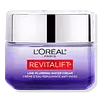What's inside
What's inside
 Key Ingredients
Key Ingredients

 Benefits
Benefits

 Concerns
Concerns

 Ingredients Side-by-side
Ingredients Side-by-side

Water
Skin ConditioningPropylene Glycol
HumectantGlycerin
HumectantDimethicone
EmollientAlcohol Denat.
AntimicrobialOctyldodecanol
EmollientCaprylyl Methicone
Skin ConditioningBetaine
HumectantNiacinamide
SmoothingIsohexadecane
EmollientHydroxypalmitoyl Sphinganine
Skin ConditioningSodium Acetylated Hyaluronate
HumectantSodium Hyaluronate
HumectantSodium Hydroxide
Buffering2-Oleamido-1,3-Octadecanediol
Skin ConditioningTocopheryl Acetate
AntioxidantCeramide NP
Skin ConditioningHydrogenated Lecithin
EmulsifyingAcrylates/C10-30 Alkyl Acrylate Crosspolymer
Emulsion StabilisingCarbomer
Emulsion StabilisingXanthan Gum
EmulsifyingDimethiconol
EmollientChlorphenesin
AntimicrobialPhenoxyethanol
PreservativeWater, Propylene Glycol, Glycerin, Dimethicone, Alcohol Denat., Octyldodecanol, Caprylyl Methicone, Betaine, Niacinamide, Isohexadecane, Hydroxypalmitoyl Sphinganine, Sodium Acetylated Hyaluronate, Sodium Hyaluronate, Sodium Hydroxide, 2-Oleamido-1,3-Octadecanediol, Tocopheryl Acetate, Ceramide NP, Hydrogenated Lecithin, Acrylates/C10-30 Alkyl Acrylate Crosspolymer, Carbomer, Xanthan Gum, Dimethiconol, Chlorphenesin, Phenoxyethanol
Water
Skin ConditioningButylene Glycol
HumectantDimethicone/Vinyl Dimethicone Crosspolymer
Skin ConditioningCyclopentasiloxane
EmollientLactobionic Acid
BufferingLactic Acid
BufferingGlycerin
HumectantCyclohexasiloxane
Emollient1,2-Hexanediol
Skin ConditioningHydroxyacetophenone
AntioxidantMethyl Gluceth-20
HumectantCarbomer
Emulsion StabilisingSalicylic Acid
MaskingSophora Flavescens Root Extract
AntioxidantTrehalose
HumectantAmmonium Acryloyldimethyltaurate/Vp Copolymer
Pentylene Glycol
Skin ConditioningOphiopogon Japonicus Root Extract
Skin ConditioningOpuntia Ficus-Indica Stem Extract
Skin ConditioningSodium Salicylate
PreservativePortulaca Oleracea Extract
Skin ConditioningTribulus Terrestris Fruit Extract
Skin ConditioningSodium Hydroxide
BufferingDisodium EDTA
10-Hydroxydecanoic Acid
Skin ConditioningCornus Officinalis Fruit Extract
Skin ConditioningPanthenol
Skin ConditioningEctoin
Skin ConditioningCI 42090
Cosmetic ColorantArginine/Lysine Polypeptide
Skin ConditioningMaltodextrin
AbsorbentCentella Asiatica Leaf Extract
Skin ConditioningPropylene Glycol
HumectantGlycolic Acid
BufferingPolysorbate 80
EmulsifyingSodium Magnesium Silicate
Citric Acid
BufferingCaprylic/Capric Triglyceride
MaskingXanthan Gum
EmulsifyingSimmondsia Chinensis Seed Oil
EmollientButyrospermum Parkii Butter
Skin ConditioningTocopheryl Acetate
AntioxidantWater, Butylene Glycol, Dimethicone/Vinyl Dimethicone Crosspolymer, Cyclopentasiloxane, Lactobionic Acid, Lactic Acid, Glycerin, Cyclohexasiloxane, 1,2-Hexanediol, Hydroxyacetophenone, Methyl Gluceth-20, Carbomer, Salicylic Acid, Sophora Flavescens Root Extract, Trehalose, Ammonium Acryloyldimethyltaurate/Vp Copolymer, Pentylene Glycol, Ophiopogon Japonicus Root Extract, Opuntia Ficus-Indica Stem Extract, Sodium Salicylate, Portulaca Oleracea Extract, Tribulus Terrestris Fruit Extract, Sodium Hydroxide, Disodium EDTA, 10-Hydroxydecanoic Acid, Cornus Officinalis Fruit Extract, Panthenol, Ectoin, CI 42090, Arginine/Lysine Polypeptide, Maltodextrin, Centella Asiatica Leaf Extract, Propylene Glycol, Glycolic Acid, Polysorbate 80, Sodium Magnesium Silicate, Citric Acid, Caprylic/Capric Triglyceride, Xanthan Gum, Simmondsia Chinensis Seed Oil, Butyrospermum Parkii Butter, Tocopheryl Acetate
 Reviews
Reviews

Ingredients Explained
These ingredients are found in both products.
Ingredients higher up in an ingredient list are typically present in a larger amount.
Carbomer is a polymer of acrylic acid. Its main role is to create a gel consistency.
A high amount of carbomer can cause pilling or balling up of products. Don't worry, most products contain 1% or less of carbomer.
Glycerin is already naturally found in your skin. It helps moisturize and protect your skin.
A study from 2016 found glycerin to be more effective as a humectant than AHAs and hyaluronic acid.
As a humectant, it helps the skin stay hydrated by pulling moisture to your skin. The low molecular weight of glycerin allows it to pull moisture into the deeper layers of your skin.
Hydrated skin improves your skin barrier; Your skin barrier helps protect against irritants and bacteria.
Glycerin has also been found to have antimicrobial and antiviral properties. Due to these properties, glycerin is often used in wound and burn treatments.
In cosmetics, glycerin is usually derived from plants such as soybean or palm. However, it can also be sourced from animals, such as tallow or animal fat.
This ingredient is organic, colorless, odorless, and non-toxic.
Glycerin is the name for this ingredient in American English. British English uses Glycerol/Glycerine.
Learn more about GlycerinPropylene Glycol is an odorless, colorless liquid. As a humectant, it helps skin retain moisture. It also aids in delivering active ingredients.
Another role of this ingredient is preventing a product from melting or freezing. Propylene glycol also adds antimicrobrial properties to a product, elongating product lifespan.
This ingredient is considered an organic alcohol and commonly added into both cosmetics and foods.
Those with sensitive skin or conditions may develop a rash when using this ingredient.
Learn more about Propylene GlycolSodium Hydroxide is also known as lye or caustic soda. It is used to adjust the pH of products; many ingredients require a specific pH to be effective.
In small amounts, sodium hydroxide is considered safe to use. However, large amounts may cause chemical burns due to its high alkaline.
Your skin has a natural pH and acid mantle. This acid mantle helps prevent harmful bacteria from breaking through. The acid mantle also helps keep your skin hydrated.
"Alkaline" refers to a high pH level. A low pH level would be considered acidic.
Learn more about Sodium HydroxideTocopheryl Acetate is AKA Vitamin E. It is an antioxidant and protects your skin from free radicals. Free radicals damage the skin by breaking down collagen.
One study found using Tocopheryl Acetate with Vitamin C decreased the number of sunburned cells.
Tocopheryl Acetate is commonly found in both skincare and dietary supplements.
Learn more about Tocopheryl AcetateWater. It's the most common cosmetic ingredient of all. You'll usually see it at the top of ingredient lists, meaning that it makes up the largest part of the product.
So why is it so popular? Water most often acts as a solvent - this means that it helps dissolve other ingredients into the formulation.
You'll also recognize water as that liquid we all need to stay alive. If you see this, drink a glass of water. Stay hydrated!
Learn more about WaterXanthan gum is used as a stabilizer and thickener within cosmetic products. It helps give products a sticky, thick feeling - preventing them from being too runny.
On the technical side of things, xanthan gum is a polysaccharide - a combination consisting of multiple sugar molecules bonded together.
Xanthan gum is a pretty common and great ingredient. It is a natural, non-toxic, non-irritating ingredient that is also commonly used in food products.
Learn more about Xanthan Gum